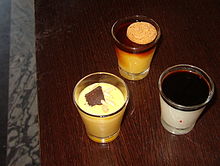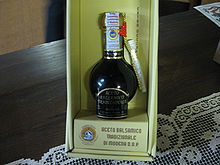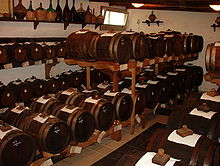- Balsamic vinegar
-
Balsamic vinegar (Italian: aceto balsamico) is a condiment originating from Italy.
The original traditional product (Aceto Balsamico Tradizionale), made from a reduction of cooked white Trebbiano grape juice and not a vinegar in the usual sense, has been made in Modena and Reggio Emilia[1] since the Middle Ages: the production of the balsamic vinegar is mentioned in a document dated 1046. During the Renaissance, it was appreciated in the House of Este.[2] Today, the traditional balsamic vinegar is highly valued by chefs and gourmet food lovers.
The names "Aceto Balsamico Tradizionale di Modena" (Traditional Balsamic Vinegar of Modena) and "Aceto Balsamico Tradizionale di Reggio Emilia" (Traditional Balsamic Vinegar of Reggio Emilia) are protected by both the Italian Denominazione di origine protetta and the European Union's Protected Designation of Origin.
Balsamic Vinegar of Modena (Aceto Balsamico di Modena), an inexpensive modern imitation of the traditional product, is today widely available and much better known. This is the kind commonly used for salad dressing together with oil.
The word balsamico (from Latin balsamum, from Greek balsamon) means "balsam-like" in the sense of "restorative" or "curative".[3]
Contents
Classifications of balsamic vinegar
There are three types of balsamic vinegar:
- Authentic traditional artisan balsamic vinegar, the only kind that may legally be described as Aceto Balsamico Tradizionale in the Euro-zone.
- Commercial grade balsamic vinegars produced on an industrial scale.
- Condimento grade products, which are often a mix of the two above.
Aceto Balsamico Tradizionale
Main article: Traditional Balsamic VinegarOnly two consortia produce true traditional balsamic vinegar, Reggio Emilia and neighboring Modena. True balsamic vinegar is made from a reduction of pressed Trebbiano and Lambrusco grapes.[4] The resulting thick syrup, called mosto cotto in Italian, is subsequently aged for a minimum of 12 years in a battery of seven barrels of successively smaller sizes. The casks are made of different woods like chestnut, acacia, cherry, oak, mulberry, ash, and, in the past, juniper. True balsamic vinegar is rich, glossy, deep brown in color and has a complex flavour that balances the natural sweet and sour elements of the cooked grape juice with hints of wood from the casks.
Reggio Emilia designates the different ages of their balsamic vinegar (Aceto Balsamico Tradizionale di Reggio Emilia) by label colour. A red label means the vinegar has been aged for at least 12 years, a silver label that the vinegar has aged for at least 18 years and a gold label that designates the vinegar has aged for 25 years or more.[5]
Modena uses a different system to indicate the age of its balsamic vinegars (Aceto Balsamico Tradizionale di Modena). A cream-coloured cap means the vinegar has aged for at least 12 years and a magenta cap bearing the designation extravecchio (extra old) shows the vinegar has aged for 25 years or more.[5]
Condimento grade balsamic vinegar
Condimento balsamic vinegars may be labeled as condimento balsamico, salsa balsamica or salsa di mosto cotto. Condimento balsamic vinegar may be made in any of the following ways:
- Made and aged in the traditional way in Modena or Reggio Emilia, but without consortium supervision and approval until 2009, but now with Reg.CEE n. 583/2009 the product is IGP (PGI)
- Made by producers of tradizionale balsamic vinegars but aged less than the minimum 12 years, so no consortium approval is possible
- Made by the same method as the tradizionale vinegars, but made by producers located outside of Modena and Reggio Emilia provinces and not made under consortium supervision
- Made of ordinary balsamic vinegar (see below) with the addition of reduced grape juice (mosto cotto) in varying proportions, without any aging
As there are no official standards or labeling systems to designate condimento balsamic vinegars, it can be hard to tell their quality based on the packaging alone.[1]
Balsamic Vinegar of Modena
These commercial grade products imitate the traditional product. They are made of wine vinegar with the addition of colouring, caramel and sometimes thickeners like guar gum or cornflour to artificially simulate the sweetness and thickness of the aged Aceto Balsamico Tradizionale di Modena. There is no aging involved, and hundreds of thousands of litres can be produced every day.
Traditional processes
Traditional balsamic vinegar is produced from the juice of just-harvested white grapes (typically, Trebbiano grapes) boiled down to approximately 30% of the original volume to create a concentrate or must, which is then fermented with a slow aging process which concentrates the flavours. The flavour intensifies over the years, with the vinegar being stored in wooden casks, becoming sweet, viscous and very concentrated. During this period, a portion evaporates: it is said that this is the "angels' share," a term also used in the production of scotch whisky, wine, and other alcoholic beverages.
None of the product may be withdrawn until the end of the minimum aging period of 12 years. At the end of the aging period (12, 18, or 25 years) a small portion is drawn from the smallest cask and each cask is then topped up with the contents of the preceding (next larger) cask. Freshly reduced cooked must is added to the largest cask and in every subsequent year the drawing and topping up process is repeated.[4] This process where the product is distributed from the oldest cask and then refilled from the next oldest vintage cask is called solera or in perpetuum.
Consortium-sealed Tradizionale balsamic vinegar 100 ml bottles can cost between US$150 and $400 each.
Uses
 Three desserts in Modena with tradizionale balsamic vinegar: clockwise from left, zabaione, latte alla portoghese or crème caramel , and panna cotta.
Three desserts in Modena with tradizionale balsamic vinegar: clockwise from left, zabaione, latte alla portoghese or crème caramel , and panna cotta.
Commercial-grade balsamic vinegar is used in salad dressings, dips, marinades, reductions and sauces.
In Emilia-Romagna, tradizionale vinegar is most often served in drops on top of chunks of Parmigiano Reggiano and mortadella as an antipasto. It is also used sparingly to enhance steaks, eggs or grilled fish, as well as on fresh fruit such as strawberries and pears and on plain crema (custard) gelato. Tradizionale vinegar has excellent digestive properties[citation needed] and it may even be drunk from a tiny glass to conclude a meal.
Contemporary chefs use both tradizionale and condimento vinegars sparingly in simple dishes where the balsamic vinegar's complex tastes are highlighted, using it to enhance dishes like scallops or shrimp, or on simple pastas and risottos.
See also
- Traditional Balsamic Vinegar
- http://dictionary.reference.com/browse/balsam
References
- ^ a b Bertolli, Paul. "Balsamic Vinegar is Italy's Famed Elixir". Taunton's Fine Cooking. Taunton Press. http://www.finecooking.com/articles/balsamic-vinegar-famed-elixir.aspx. Retrieved 2006-08-20.
- ^ In Vita Mathildis del monaco benedettino Donizone, XI secolo.
- ^ Merriam-Webster's collegiate dictionary (11 ed.), Merriam-Webster, 2003, p. 95, ISBN 9780877798095, http://books.google.co.uk/books?id=O78rzaI2XmUC&pg=RA1-PA95&dq=balsamic+balsam#v=onepage&q=balsamic%20balsam&f=false, retrieved 2009-10-10
- ^ a b "Consorzio Produttori Aceto Balsamico Tradizionale di Modena". http://www.balsamico.it/. Retrieved 2010-03-25.
- ^ a b Harlan, Timothy S. (M.D.). "Ask Dr. Gourmet". Dr. Gourmet. Harlan Bros. Productions. http://www.drgourmet.com/askdrgourmet/balsamicvinegar.shtml. Retrieved 2006-08-20.
Salad dressings Types Blue cheese dressing • Caesar dressing • Catalina dressing • Olive oil • French dressing • Ginger dressing • Green goddess dressing • Italian dressing • Louis dressing • Mayfair salad dressing • Ranch dressing • Russian dressing • Salad cream • Thousand Island dressing • Vinaigrette • Wafu dressingBrands Categories:- Italian cuisine
- Salad dressings
- Reggio Emilia
- Modena
- Italian products with protected designation of origin
- Vinegar
Wikimedia Foundation. 2010.



